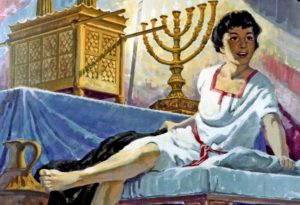“The lamp of God had not yet gone out;
and Sh’mu’el had lain down to sleep
in the sanctuary of Adonai,
where the ark of God was.”
-1 Samuel 3:3
So verse 3 tells us that Samuel went to sleep in the sanctuary where the Ark was.
However, the original Hebrew says Samuel was sleeping in the HEKAL or הֵיכָל.
Now this word has caused scholars big time confusion in terms of where exactly Samuel fell asleep.
Was he sleeping in the Holy Place where the Menorah, the Table of Shewbread and the Incense Altar was?
Or was he sleeping somewhere else.
See, the problem with the word HEKAL is that it possesses multiple meanings.
In a general sense, it means a “big dwelling place”.
But to add to the confusion, it can also mean a “temple”.
And when I say “temple”, I mean any temple…
Including the pagan temples of the Canaanites.
So within this context, here’s what I think HEKAL means.
I think it refers to the whole courtyard of the Lord’s dwelling place.
Kind of like how the term “Wilderness Tabernacle”, does NOT just refer to the sacred tent itself…
But also includes all of the surrounding courtyard.
Ya feel me here?
Another interesting thing to note is that at this stage in Israel’s history, the term “Tabernacle” fell into disuse and was actually replaced by the word HEKAL.
Why?
Well, keep in mind by this time a whopping 400 years had passed since the original Tabernacle was built at the base of Mount Sinai.
Recall it was a tent made out of cloth and animal skins…
And by this time had probably undergone countless repairs.
However, once Israel crossed the Jordan River into the Promised Land, they no longer had a need for a portable tent.
Instead Shiloh had become the permanent home of the Tabernacle.
The original portable tent after many repairs had probably been made into a much more sturdy and permanent piece of construction by this time.
And lets not forget that the wilderness days when the people camped around the Tabernacle were long gone.
Instead, everyone was now living in brick and stone houses in their own tribal territories.
It was only Eli and his family who lived permanently at Shiloh.
The other Levites, when it was their turn to serve, probably stayed in what could best be described as a dormitory that had been built for their temporary stay.
So this is the image we should have in mind in this context.
Now there’s a special reason why the author says that Samuel was near the Ark when the Lord called out to him.
Remember the Ark was considered to be the Lord’s dwelling place on earth…
God hovered above the Ark whenever He spoke to Israel.
And the Mercy Seat was considered to be his footstool.
So that’s why the Biblical author tells us that Samuel fell asleep near the Ark…
Because is there any other more appropriate place where God would have called out to Samuel?




So awesome to think of that little boy sleeping close enough to the Ark to hear the Voice!
Quote: “The original portable tent after many repairs had probably been made into a much more sturdy and permanent piece of construction by this time.”
Yep —
To the north of the summit of the hill, is a large, flat rectangular surface that is cleared to the bedrock. It is evident that this space has been artificially hewn, or at least enhanced to its current size and shape. Today this feature is called the “Tabernacle Plateau”. It is large enough to have accommodated the Tabernacle and its courtyard.
—-
By this point the Tabernacle had been situated there for centuries and the original courtyard curtain-walls seem to have been replaced with stone walls.
—-
Archeologists working on the Tabernacle Plateau had discovered a number of holes carved into the ground. These holes it is suggested once held [beams] in place that may have supported the Tabernacle itself.
https://biblereadingarcheology.com/2016/08/18/i-will-make-this-house-like-shiloh/
https://www.archaeology.wiki/blog/2013/11/21/archaeologists-find-shiloh-altar-used-during-temple-era/
Thanks for sharing the supporting info Eric!